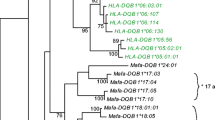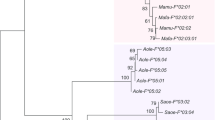Abstract
Although the functions of the molecules encoded by the classical MHC class I loci are well defined, no function has been ascribed to the molecules encoded by the non-classical MHC class I loci. To investigate the evolution and conservation of the non-classical loci, we cloned and sequenced HLA-E homologues in macaques. We isolated four E locus alleles from five rhesus monkeys and two E locus alleles from one cynomolgus monkey, which indicated that the E locus in macaques is polymorphic. We also compared the rate of nucleotide substitution in the second intron of the macaque and human E locus alleles with that of exons two and three. The rate of nucleotide substitution was significantly higher in the introns, which suggested that the E locus has evolved under selective pressure. Additionally, comparison of the rates of synonymous and non-synonymous substitutions in the peptide binding region versus the remainder of the molecule suggested that the codons encoding the amino acids in the peptide binding region had been conserved in macaques and humans over the 36 million years since macaques and humans last shared a common ancestor.
Similar content being viewed by others
References
Biro, P. A., Pan, J., Sood, A. K., Kole, R., Reddy, V. B., and Weissman, S. M. The major histocompatibility complex. CSH Symp Quant Biol 47: 1079–1086, 1983
Bjorkman, P. J., Saper, M. A., Samraoui, B., Bennet, W. S., Strominger, J. L., and Wilery, D. C. Structure of the human class I histocompatibility antigen, HLA-A2. Nature 329: 506–512, 1987a
Bjorkman, P. J., Saper, M. A., Samraoui, B., Bennet, W. S., Strominger, J. L., and Wiley, D. C. The foreign antigen binding site and T cell recognition regions of class I histocompatibility antigens. Nature 329: 512–518, 1987b
Bluestone, J. A., Cron, R. Q., Cotterman, M., Houlden, B. A., and Matis, L. A. Structure and specificity of T cell receptor γ/δ on major histocompatibility complex antigen specific CD3+, CD4−, CD8−T lymphocytes. J Exp Med: 1899–1916, 1988
Cowan, E. P., Jelachich, M. L., Biddison, W. E., and Colligan, J. E. DNA sequence of HLA-A11: remarkable homology with HLA-A3 allows identification of residues involved in epitopes recognized by antibodies and T cells. Immunogenetics 25: 241–250, 1987
Ennis, P. D., Zemmour, J., Salter, R. D., and Parham, P. Rapid cloning of HLA-A, B cDNA by using the polymerase chain reaction: frequency and nature of errors produced in amplification. Proc Natl Acad Sci USA 87: 2833–2837, 1990
Geraghty, D. E., Koller, B. H., and Orr, H. T. A human major histocompatibility complex class I gene that encodes a protein with a shortened cytoplasmic segment. Proc Natl Acad Sci USA 84: 9145–9148, 1987
Geraghty, D. E., Wei, X., Orr, H. T., and Koller, B. H. HLA-F: an expressed HLA gene composed of a class I coding sequence linked to a novel transcribed repetitive element. J Exp Med 171: 1–18, 1990
Geraghty, D. E., Stockschleader, M., Ishitani, A., and Hansen, J. A. Polymorphism at the HLA-E locus predates most HLA-A and —B polymorphism. Hum Immunol 33: 174–184, 1992
Girdlestone, J. Nucleotide sequence of an HLA-A1 gene. Nucleic Acids Res 18: 6701, 1990
Golos, T. G., Handrow, R. R., Durning, M., Fisher, J. M, and Rilling, J. K. Regulation of chorionic gonadotropin-a and chorionic sommatomammotropin messenger ribonucleic acid expression by 8-bromo-adenosine 3', 5'-monophosphate and dexamehasone in cultured rhesus money syncytiotrophoblasts. Endocrinology 131: 89–100, 1992
Gussow, D., Rein, R. S., Meijer, I., de Hoog, W., Seemann, G. H., Hochstenbach, F. M., and Ploegh, H. L. Isolation, expression and the primary structure of HLA-Cw1 and HLA-Cw2 genes: evolutionary aspects. Immunogenetics 25: 313–322, 1987
Holmes, N. and Parham, P. Exon shuffling in vivo can generate novel HLA class I molecules. EMBO J 4: 2849–2854, 1985
Houlihan, J. M., Biro, P. A., Fergar-Payne, A., Simpson, K. L., and Holmes, C. H. Evidence for the expression of non-HLA-A,-B,-C classI genes in the human fetal liver. J Immunol 149: 668–675, 1992
Hughes, A. L., and Nei, M. Pattern of nucleotide substitution at major histocompatibility complex class I loci reveals overdominant selection. Nature 335: 167–170, 1988
Hughes, A. L. and Nei, M. Evolution of the major histocompatibility complex: independent origin on nonclassical class I gene in different groups of mammals. J Mol Biol 6: 559–579, 1989
Imani, F. and Soloski, M. J. Heat shock proteins can regulate expression of the Tla region-encoded class Ib molecule Qa-1. Proc Natl Acad Sci USA 88: 10475–10479, 1991
Ito, K., Van Kaer, L., Bonneville, M., Hsu, S., Murphy, D. B., and Tonegawa, S. Recognition of the product of a novel MHC TL region gene (27b) by a mouse γ/δ T cell receptor. Cell 62: 549–561, 1990
Jukes, T. H. and Cantor, C. R. Evolution of protein molecules. In H. N. Munro (ed.): Mammalian Protein Metabolism, pp. 21–132, Academic Press, New York, 1969
Kato, K., Trapani, J. A., Allopenna, J., Dupont, B., and Yang, S. Y. Molecular analysis of the serologically defined HLA-Aw19 antigens. A genetically distinct family of HLA-A antigens comprising A29, A31, A32, and Aw33, but probably not A30. J Immunol 143: 3371–3378, 1988
Koller, B. H., Geraghty, D. E., Shimuzu, Y., DeMars, R., and Orr, H. T. HLa-E: a novel HLA class I gene expressed in resting T lymphocytes. J Immunol 141: 897–904, 1988
Koller, B. H. and Orr, H. T. Cloning and complete sequence of an HLA-A2 gene: analysis of two HLA-A alleles at the nucleotide level. J Immunol 134(4): 2727–2733, 1988
Kovats, S., Main, E. K., Librach, C., Stubblebine, M., Fisher, S. J., and DeMars, R. A class I antigen, HLA-G, expressed in human trophoblasts. Science 248: 220–223, 1990
Lata, J. A., Tuan, R. S., Shepley, K. J., Mulligan, M. M., Jackson, L. G., and Smith, J. B. Localization of major histocompatibility complex class I and II mRNA in human first-trimester chorionic villi by in situ hybridization. J Exp Med 175: 1027–1032, 1992
Lawlor, D. A., Warren, E., Ward, F. E., and Parham, P. Comparison of class I MHC alleles in humans and apes. Immunol Rev 113: 147–185, 1990
Martin, R. D. Primate origins: plugging the gaps. Nature 363: 223–234, 1993
Miller, M. D., Yamamoto, H., Hughes, A. L., Watkins, D. I., and Letvin, N. L. Definition of an epitope and an MHC class I molecule recognized by gag-specific CTL in SIVmac infected rhesus monkeys. J Immunol 147: 320–328, 1991
N'Guyen, C., Sodoyer, R., Trucy, J., Strachan, T., and Jordan, B. R. The HLA-Aw24 gene: sequence, surroundings and comparison with the HLA-A2 and HLA-A3 genes. Immunogenetics 21: 479–489, 1985
Nei, M. and Gojobori, T. Simple methods for estimating the numbers of synonymous and nonsynonymous nucleotide substitutions. Mol Biol Evol 3: 418–426, 1986
Nei, M. and Jin, L. Variances of the average numbers of nucleotide substitutions within and between populations. Mol Biol Evol 6: 290–300, 1989
Otting, N. and Bontrop, R. E. Characterization of the rhesus macaque (Macaca mulatta) equivalent of HLA-F Immunogenetics 38: 141–145, 1993
Pamer, E. G., Wang, C., Flaherty, L., Fischer Lindahl, K., and Bevan, M. J. H-2M3 presents a Listeria monocytogenes peptide to cytotoxic T lymphocytes. Cell 70: 215–223, 1992
Parham, P., Lawlor, D. A., Salter, R. D., Lomen, C. E., and Ennis, P. D. Diversity and diversification of HLA-A, B, C alleles. J Immunol 142: 3937–3950, 1989
Parham, P., Lomen, C. E., Lawlor, D. A., Ways, J. P., Holmes, N., Coppin, H. L., Salter, R. D., Wan, A. M., and Ennis, P. D. The nature of polymorphism in HLA-A,-B,and-C molecules. Proc Natl Acad Sci USA 85: 4005–4009, 1988
Porcelli, S., Brenner, M. B., Greenstein, J. L., Balk, S. P., Terhorst, C., and Bleicher, P. A. Recognition of cluster of differentiation 1 antigens by human CD4–8- cytolytic T lymphocytes. Nature 341: 447–450, 1989
Porcelli, S., Morita, C. T., and Brenner, M. B. CD1b restricts the response of human CD4–8-T lymphocytes to a microbial antigen. Nature 360: 593–597, 1992
Saiki, R. K., Gelfand, D. H., Stoffel, S.J., Scharf, S. J., Higuchi, R., Horn, G. T., and Mullis, K. B. Primer-directed enzymatic amplification of DNA with a thermostable DNA polymerase. Science 239: 487–491, 1988
Sanger, F., Nicklen, S., and Coulson, A. R. DNA sequencing with chain-terminating inhibitors. Proc Natl Acad Sci USA 74: 5463–5467, 1977
Shukla, H., Swaroop, A., Srivastava, R., and Weisman, S. M. The mRNA of a human class I gene HLA-G/HLA 6.0 exhibits a restricted pattern of expression. Nucleic Acids Res 18: 2189, 1990
Srivastava, R., Chorney, M. J., Lawrance, S. K., Pan, J., Smith, Z., Smith, C. L., and Weisman, S. M. Structure, expression, and molecular mapping of a divergent member of the class I HLA gene family. Proc Natl Acad Sci USA 84: 4224–4228, 1987
Strachan, T., Sodoyer, R., Damotte, M., and Jordan, B. R. Complete nucleotide sequence of a functional class I HLA gene, HLA-A3: implications for the evolution of HLA genes. EMBO J 3: 887–894, 1984
Stroynowski, I. Molecules related to class-I major histocompatibility complex antigens. Annu Rev Immunol 8: 501–530, 1990
Townsend, A. R. M., Rothbard, J., Gotch, F. M., Bahadur, G., Wraith, D., and McMichael, A. J. The epitopes of influenza nucleoprotein peptides. Cell 44: 959–968, 1986
Trapani, J. A., Mizuno, S., Kang, S. H., Yang, S. Y., and Dupont, B. Molecular mapping of a new public HLA class I epitope shared by all HLA-B and HLA-C antigens and defined by a monoclonal antibody. Immunogenetics 29: 25–32, 1989
Ulbrecht, M., Honka, T., Person, S. E., Johnson, J. P., and Weiss, E. H. The HLA-E gene encodes two differentially regulated transcripts and a cell surface protein. J Immunol 149: 2945–2953, 1992a
Ulbrecht, M., Kellermann, J., Johnson, J. P., and Weiss, E. H. Impaired intracellular transport and cell surface expression of nonpolymorphic HLA-E: evidence of insufficient peptide binding. J Exp Med 176: 1083–1090, 1992b
Vidovic, D., Roglic, M., McKune K., Guerder, S., MacKay, C., and Dembic, Z. Qa-1 restricted recognition of foreign antigen by a γ/δ T-cell hybridoma. Nature 340: 646–650, 1989
Wan, A. M., Ennis, P. D., Parham, P., and Holmes, N. The primary structure of HLA-A32 suggests a region involved in formation of the Bw4/Bw6 epitopes. J Immunol 137: 3671–3674, 1988
Watkins, D. I., Garber, T. L., Chen, Z. W., Toukatly, G., Hughes, A. L., and Letvin, N. L. Unusually limited nucleotide sequence variation of the expressed major histocompatibility complex class I genes of a New World primate species (Saguinus oedipus.). Immunogenetics 33: 79–89, 1991
Wei, X. and Orr, H. T. Differential expression of HLA-E, HLA-F, and HLA-G transcripts in human tissue. Hum Immunol 29: 131–142, 1990
Yelavarthi, K. K., Fishback, J. L., and Hunt, J. S. Analysis of HLA-G in human placental and extra placental membrane cells by in situ hybridization. J Immunol 146: 2847–2854, 1991
Zinszner, H., Masset, M., Bourge, J. F., Colombani, J., Cohen, D., Degos, L., and Paul, P. Nucleotide sequence of the HLA-A26 class I gene: identification of specific residues and molecular mapping of public HLA class I epitopes. Hum Immunol 27: 155–166, 1990
Author information
Authors and Affiliations
Additional information
The nucleotide sequence data reported in this paper have been submitted to the GenBank nucleotide sequence database and have been assigned the accession numbers UO2976–UO2981
Rights and permissions
About this article
Cite this article
Boyson, J.E., McAdam, S.N., Gallimore, A. et al. The MHC E locus in macaques is polymorphic and is conserved between macaques and humans. Immunogenetics 41, 59–68 (1995). https://doi.org/10.1007/BF00182314
Received:
Revised:
Issue Date:
DOI: https://doi.org/10.1007/BF00182314




